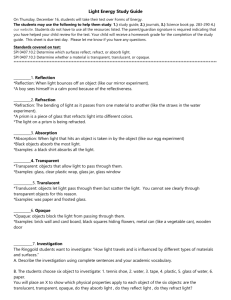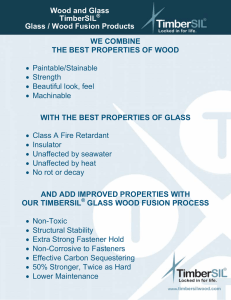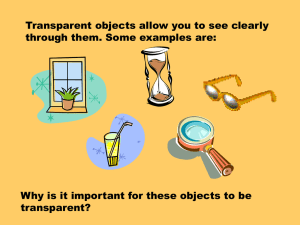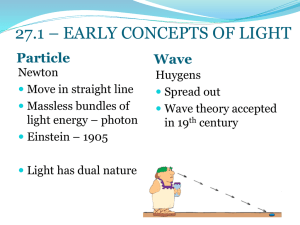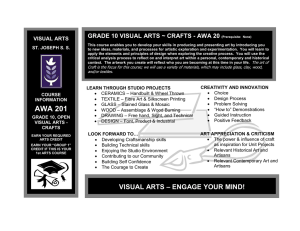Sorting Materials into Groups
advertisement
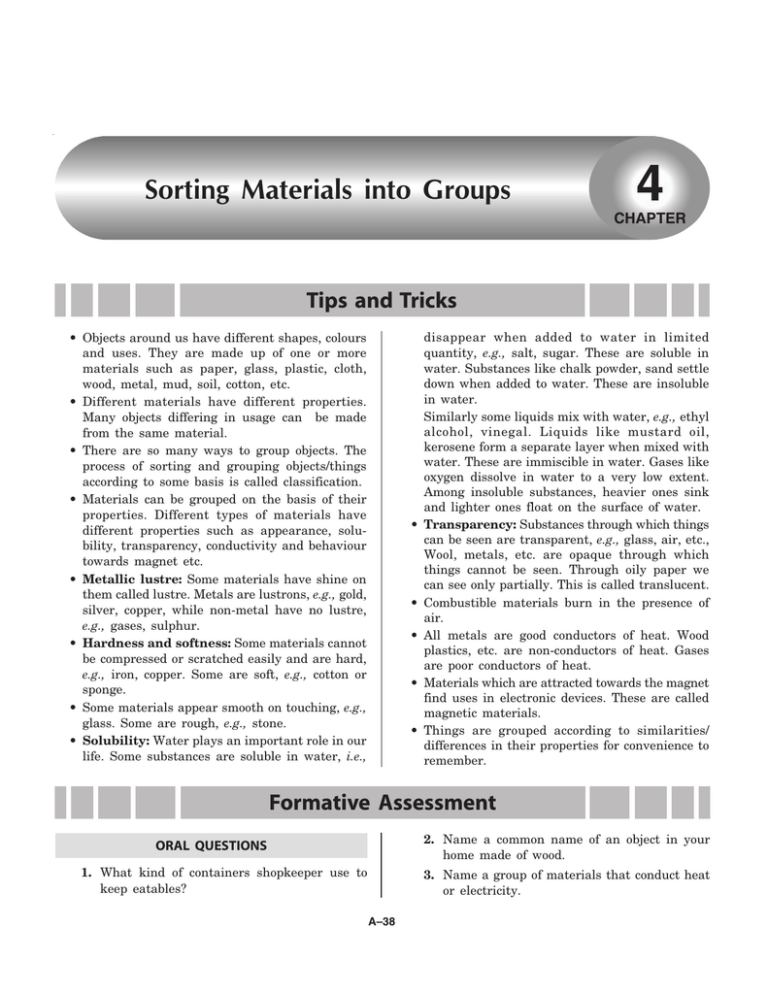
Sorting Materials into Groups 4 CHAPTER Tips and Tricks • Objects around us have different shapes, colours and uses. They are made up of one or more materials such as paper, glass, plastic, cloth, wood, metal, mud, soil, cotton, etc. • Different materials have different properties. Many objects differing in usage can be made from the same material. • There are so many ways to group objects. The process of sorting and grouping objects/things according to some basis is called classification. • Materials can be grouped on the basis of their properties. Different types of materials have different properties such as appearance, solubility, transparency, conductivity and behaviour towards magnet etc. • Metallic lustre: Some materials have shine on them called lustre. Metals are lustrons, e.g., gold, silver, copper, while non-metal have no lustre, e.g., gases, sulphur. • Hardness and softness: Some materials cannot be compressed or scratched easily and are hard, e.g., iron, copper. Some are soft, e.g., cotton or sponge. • Some materials appear smooth on touching, e.g., glass. Some are rough, e.g., stone. • Solubility: Water plays an important role in our life. Some substances are soluble in water, i.e., • • • • • disappear when added to water in limited quantity, e.g., salt, sugar. These are soluble in water. Substances like chalk powder, sand settle down when added to water. These are insoluble in water. Similarly some liquids mix with water, e.g., ethyl alcohol, vinegal. Liquids like mustard oil, kerosene form a separate layer when mixed with water. These are immiscible in water. Gases like oxygen dissolve in water to a very low extent. Among insoluble substances, heavier ones sink and lighter ones float on the surface of water. Transparency: Substances through which things can be seen are transparent, e.g., glass, air, etc., Wool, metals, etc. are opaque through which things cannot be seen. Through oily paper we can see only partially. This is called translucent. Combustible materials burn in the presence of air. All metals are good conductors of heat. Wood plastics, etc. are non-conductors of heat. Gases are poor conductors of heat. Materials which are attracted towards the magnet find uses in electronic devices. These are called magnetic materials. Things are grouped according to similarities/ differences in their properties for convenience to remember. Formative Assessment 2. Name a common name of an object in your home made of wood. ORAL QUESTIONS 1. What kind of containers shopkeeper use to keep eatables? 3. Name a group of materials that conduct heat or electricity. A–38 SORTING MATERIALS INTO GROUPS A-39 4. Name a group of materials that have shining surface. 5. We are a group of materials that are highly compressible and are poor conductors of heat. 5. Water when mixed with mustard oil forms two layers. Are these miscible or immiscible? 6. I am a tiny material but in some respect behave like our earth. 6. Washing soda added to water disappears. Is it soluble or insoluble? 7. I am a material and can be made into tumbler but cannot hold water. 7. Is clean water transparent or opaque? 8. I am an elastic material but a non-conductor of heat. 8. A material when added to water floats over it. Is it soluble or insoluble? 9. What do you call a material through which things are partially visible? 10. Name a material that is attracted towards a magnet. 9. I am a material that is generally used to make toys for children to play. 10. I have mass and volume but offer negligible resistance to the movement of men or materials. 11. What are the materials called which are difficult to compress? 12. Which kind of materials have definite shape and occupy definite space? PUZZLES A. ⇒ Across 1. A property of materials through which things can be seen. (12) TRUE OR FALSE 3. A property which describes mixing of two liquids. (11) 1. All objects are made up of only one kind of material. 4 C 2. Different objects can be made from the same material. 2 3. A looking mirror is a opaque material. 4. Things made of copper and aluminium have lustre. 5. Sorting of materials into groups is done on the basis of similarities and not differences in their properties. C D M 1T N P C R 6. An oily thin paper sheet will be trasparent. I 7. Glass, water and air form a set of transparent materials. V 8. Turmeric powder used in our food is soluble in water. 9. Materials are grouped for our convenience to study their properties. T 3M C QUIZ 4. We are a group of materials through which things are not clearly visible. T Y T Y 1. We are the materials with lustre. 3. I are hard and have a rough surface and in pieces float on water. B I 10. A paper is transparent but ink is not transparent. 2. We are the materials which can be compressed easily. Y ⇓ Vertical 2. A property to test hardness or softness of materials. (15) 4. A property of transmission of electricity. (12) A-40 NEW AGE CCE SCIENCE—VI 2 1 L S ⇓ Vertical S O 2. Mixing of two substances. (10) 4 4. A shining material to make cooking utensils. (5) S SUGGESTED PROJECTS/ACTIVITIES 3 T B E R 1. Collect 20–30 materials in your household and make a list what is the number of materials in different groups made on the basis of transparency, colour, shape, lustre, conductivity and material of which these are made. I 2. Visit to your kitchen and see how your mother has kept different eatables and basis of sorting them. Are you able to suggest a better sorting. T Y 3. Visit your school laboratory, observe the chemicals and glass weares and see how the storekeeper has kept different chemicals and glass apparatus. B. ⇒ Across 1. A property of all metals. (8) 3. A container to hold things. (7) NOTES SORTING MATERIALS INTO GROUPS A-41 Assignments Name: ........................ Class: ...... Section: ...... Roll No.: ...... Grade: ...... Teacher’s sign.: .............. CLASS ASSIGNMENT 1. What is the basis of grouping? 5. Give two differences between materials made from glass and plastics. ............................................................................ ............................................................................ ............................................................................ ............................................................................ ............................................................................ ............................................................................ ............................................................................ ............................................................................ 6. State whether a material which forms a separate layer with water, is a solid, liquid or a gas? Explain. 2. A thing can be made of different materials. Comment. ............................................................................ ............................................................................ ............................................................................ ............................................................................ ............................................................................ ............................................................................ ............................................................................ ............................................................................ ............................................................................ 7. Why do cooking utensils have handles made of wood? What will happen if these are made of iron or plastic? 3. Which group of materials are lustrous? ............................................................................ ............................................................................ ............................................................................ ............................................................................ ............................................................................ 4. Give two examples each of materials which have rough surface and smooth surface. ............................................................................ ............................................................................ ............................................................................ ............................................................................ ............................................................................ A-42 NEW AGE CCE SCIENCE—VI 8. When chalk powder or sand is added to water, it settles down. What do you infer? ............................................................................ ............................................................................ ............................................................................ ............................................................................ ............................................................................ ............................................................................ 10. When milk or glycerine are added to water, they disappear! What does it mean? ............................................................................ ............................................................................ ............................................................................ 9. How will you show that water is a transparent material? ............................................................................ ............................................................................ ............................................................................ ............................................................................ ............................................................................ NOTES SORTING MATERIALS INTO GROUPS A-43 Name: ........................ Class: ...... Section: ...... Roll No.: ...... Grade: ...... Teacher’s sign.: .............. HOME ASSIGNMENT 1. Same type of materials have different properties. Comment. ............................................................................ ............................................................................ 6. Name three materials which are good conductors of heat. ............................................................................ ............................................................................ ............................................................................ ............................................................................ ............................................................................ ............................................................................ ............................................................................ 2. Which type of material has no definite shape or volume? 7. All materials have mass and occupy space. Air is also a material. How will you prove? ............................................................................ ............................................................................ ............................................................................ 3. Give one example each of an opaque and a translucent material. ............................................................................ ............................................................................ ............................................................................ ............................................................................ ............................................................................ 4. How will you show that common salt is soluble in water? ............................................................................ ............................................................................ 8. It is easier to hold glass cup full of hot milk than steal cup full of hot milk. Explain. ............................................................................ ............................................................................ 5. Why do you need grouping? Give an example. ............................................................................ ............................................................................ ............................................................................ ............................................................................ 9. Give one difference and one similarity between a solid and a liquid material. ............................................................................ ............................................................................ ............................................................................ A-44 NEW AGE CCE SCIENCE—VI ............................................................................ ............................................................................ ............................................................................ ............................................................................ ............................................................................ ............................................................................ ............................................................................ ............................................................................ 10. What will happen if petrol is mixed with water and stirred? ............................................................................ NOTES SORTING MATERIALS INTO GROUPS A-45 Summative Assessment OTHER IMPORTANT QUESTIONS A. VERY SHORT ANSWER TYPE (1 Mark) 26. Name some liquids which are miscible with water. 1. What is a material? 27. Are all liquids transparent? 2. Name two objects in your household that are round or have a round shape. 28. Name four materials that are soluble in water. 3. Name four objects from your household that are made of wood. 4. Name at least two materials of which a plate (thali) can be made. 5. Name at least two materials of which a writing pen can be made. 6. Name four objects that can be made using paper as one of the materials. 29. Name four liquids that are immiscible with water. 30. Name four solids that are insoluble in water. B. SHORT ANSWER TYPE (2 or 3 Marks) 1. What is the basic requirement to make a tumbler? Name the materials that can be used. 2. Write two properties common to all metals. 7. Out of plastic or paper which shall be suitable to make a tumbler to keep water. 3. Name two opaque and two transparent materials. 8. Why grouping of things done? 4. Identify the materials from the following which float in water and which sink in water: wax, iron nails, paper, wood, ice, oil, sand. 9. Do metals always show lustre? 10. Why some metals lose their shine and appear dull? 11. When a substance is added to water, it disappears. What does it mean? 12. When water and oil are mixed, what will happen? 13. What is a transparent material? 14. What is an opaque material? 15. What are translucent materials? 16. Select the objects which are lustrous. gold, toy, cotton shirt, freshly cut copper rod, an iron rod. 17. An iron rod has lost its shine. What will you do? 18. Name two transparent materials. 19. Name two opaque materials. 20. What are the basis on which the materials can be grouped? 21. What are hard materials? 22. List at least two liquids which are immiscible with water. 23. Under what condition pure water can lose trasparency? 24. Name three materials that are lighter than water. 25. Name some combustible materials. 5. Select the transparent, opaque and translucent objects among the following: stone, glass, oiled paper, water, spirit, wooden door, metal sheet, palm of your hand, looking glass. 6. Classify the following materials into solubility or insolubility in water. sugar, CO2, H2, common salt, chalk, milk, curd, potassium permanganate. 7. Classify the following materials into metals and non-metals: mercury, bromine, oxygen, copper. 8. Name one metal or non-metal each which are solids or liquids at room temperature. 9. What is meant by magnetic materials? Name two each of magnetic and non-magnetic materials. 10. Write three properties of non-metals. 11. On what basis can you group the following materials? wax, wood piece, paper, mustard oil, iron nails, sand. 12. What is the importance of dissolution of oxygen in water? 13. Why do you cook food in utensils made of aluminium, copper or steel? A-46 NEW AGE CCE SCIENCE—VI 14. What are conductors and non-conductors of heat? Give examples. 20. Make a list of ten objects that are made from transparent materials. 15. Show that sugar and salt are soluble in water while chalk powder and clay are insoluble in water. 21. Answer the following questions: (i) Is air massless? (ii) Is sponge a soft or hard material? 16. Write three properties each of solid and liquid materials. (iii) Why do gases spread faster than liquids? 17. Why is tumbler not made with a piece of cloth? (iv) Why does kerosene oil form a separate layer with water? 18. Why is mercury used in making thermometers? 19. Give the materials from which the following items can be made: (v) Is cloth an insulator or conductor of electricity? Almirahs, clothes, books, utensils OBJECTIVE TYPE QUESTIONS FILL IN THE BLANKS (i) Grouping of things is done for ................. . (ii) A thing can be made from different ................. . (iii) Objects, that float on water are ................. in water. (iv) The objects through which we can see are ................. materials. (v) Materials which can be pressed easily are called ................. materials. (vi) A stone is ................. while water is ................. . (vii) Gases are ................. conductors of heat. (viii) Ice is ................. than water. (ix) Wood and plastics are ................. conductor of heat. (x) Metals are good ............. heat. MULTIPLE CHOICE QUESTIONS 1. Copper metal is (a) poor conductor of heat (b) magnetic (c) floats on water (d) soluble in water 2. Select the non-magnetic material (a) aluminium (b) toy (c) copper (d) iron vessel 3. Select the material insoluble in water (a) sugar (b) washing soda (c) sand (d) copper sulphate 4. Select the odd material (a) rose (b) boat (c) lotus (d) marigold 5. Butter paper will be (a) transparent (b) opaque (c) translucent (d) oily 6. Select a right pair of materials. (a) Alum and water (b) Air and steel spoon (c) Milk and glass (d) Glass and water 7. Select an insoluble material in water. (a) alum (b) copper sulphate (c) washing powder (d) turmeric powder 8. A substance that allows the heat to pass through it is called (a) insulator (b) conductor (c) opaque (d) lustrous 9. A liquid containing a dissolved material is called (a) solution (b) solubility (c) solvent (d) all 10. Select a good conductor of heat. (a) Glass (b) Graphite (c) Rubber (d) Wood MATCH THE COLUMN Match the items under Column I and Colum II. A. Column I (a) Notebook (b) Shoes Column II (i) Leather (ii) Wood (c) Tumbler (iii) Paper (d) Table (iv) Steel (e) Almirah (v) Glass SORTING MATERIALS INTO GROUPS B. Column I (a) Tumbler (b) Sugar A-47 (c) Wax (d) Iron nails (e) Chalk powder Column II (i) Floats on water (ii) Magnetic (iii) Insoluble in water (iv) Soluble in water (v) Transparent NCERT TEXTBOOK QUESTIONS (Page 33) 1. Name five objects which can be made from wood. 2. Select those objects from the following which shine: Glass bowl, plastic toy, steel spoon, cotton shirt. 3. Match the objects given below with the materials from which they could be made. Remember, an object could be made from more than one material and a given material could be used for making many objects. Objects Materials Book Glass Tumbler Wood Chair Paper Toy Leather Shoes Plastics (ii) A notebook has lustre while eraser does not. (iii) Chalk dissolves in water. (iv) A piece of wood floats on water. (v) Sugar does not dissolve in water. (vi) Oil mixes with water. (vii) Sand settles down in water. (viii) Vinegar dissolves in water. 5. Given below are the names of some objects and materials: Water, basket ball, orange, sugar, globe, apple and earthen pitcher Group them as: (a) Round shaped and other shapes (b) Eatables and non eatables 6. List all items known to you that float on water. Check and see if they will float on an oil or kerosene. 7. Find the odd one out from the following: 4. State whether the statements given below are True or False: (i) Stone is transparent, while glass is opaque. (a) Chair, Bed, Table, Baby, Cupboard (b) Rose, Jasmine, Boat, Marigold, Lotus (c) Aluminium, Iron, Copper, Silver, Sand (d) Sugar, Salt, Sand, Copper Sulphate NOTES

